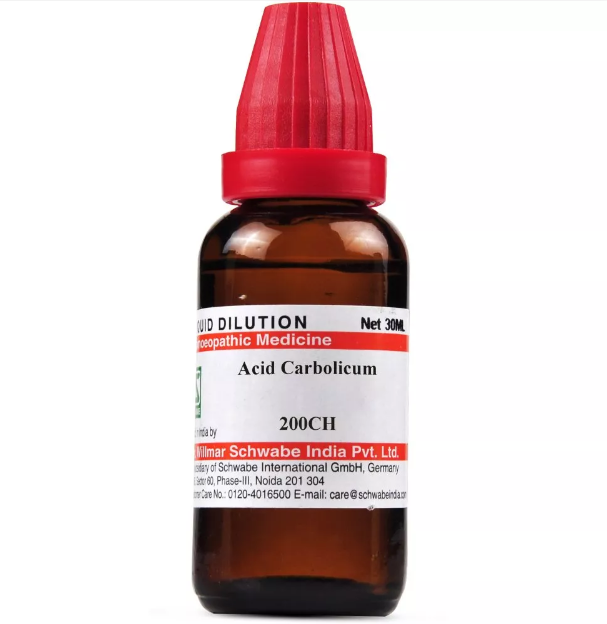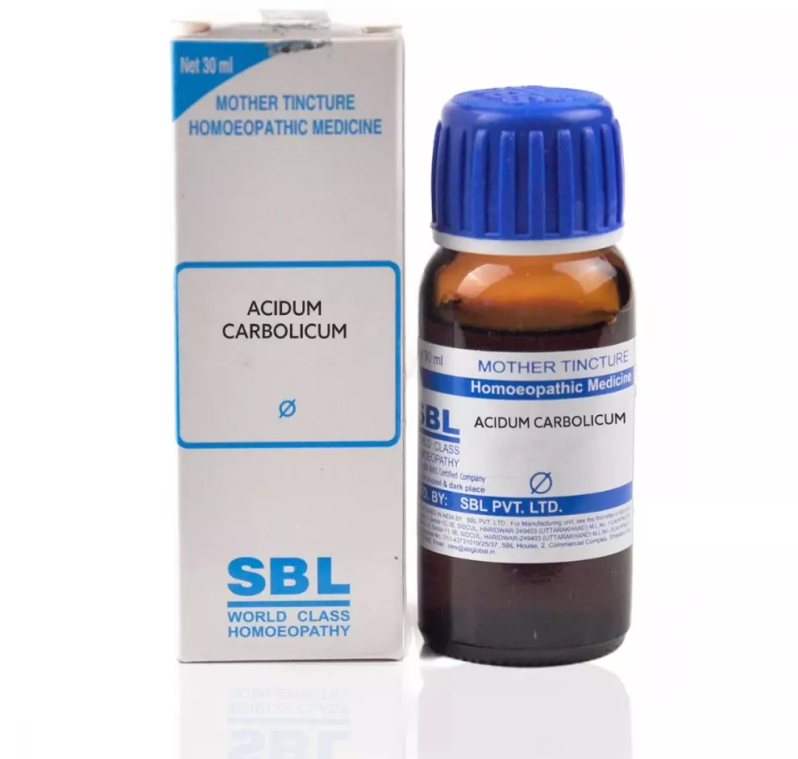CARBOLICUM ACIDUM Q, 6C, 12C, 30C, 200C, 1M, 10M USES AND SYMPTOMS
 CARBOLICUM ACIDUM
CARBOLICUM ACIDUM
(Phenol, Carbolic Acid)
Carb-ac.
Carbolicum acidum, also known as Carb-ac., is a strong irritant and anesthetic. It is a languid, foul remedy that causes painless destruction. Symptoms include stupor, paralysis of sensation and movement, weak pulse, and depressed breathing, leading to death by respiratory center paralysis. It primarily affects the central nervous system, increasing olfactory sensitivity.
It induces mental and physical lethargy, aversion to study, headache, and a sensation of a tight band around the head. An increased sense of smell is a key symptom. Important stomach symptoms include severe, sudden pains and abscesses triggered by physical exertion. There are putrid discharges, as seen in scarlet fever with tissue destruction and foul odor, spasmodic cough, and arthritis.
Head: Aversion to mental work, feeling of tightness like a rubber band (hydrocephalus). Orbital neuralgia over the right eye. Headache improves with green tea and smoking.
Nose: Highly acute sense of smell, putrid discharge, ozena with foul smell and ulcers, influenza with resulting weakness.
Throat: Ulcerated patches in the mouth, burning sensation from mouth to stomach, red fauces with exudation, shriveled white uvula, putrid discharge, difficulty swallowing, diphtheria with fetid breath, regurgitation on swallowing liquids, dusky red face with white around mouth and nose, rapid decline of vital forces.
Stomach: Loss of appetite, craving for stimulants and tobacco, constant belching, nausea, vomiting dark olive green, heat rising up the esophagus, flatulent distention, painful localized flatulence, fermentative dyspepsia with bad taste and breath.
Stool: Constipation with offensive breath, bloody stool like intestinal scrapings, great tenesmus, diarrhea with thin, black, putrid stools.
Urinary: Almost black urine, diabetes, irritable bladder in elderly men with frequent night urination, likely due to prostate issues.
Female: Always offensive discharges, pustules around the vulva with bloody pus, agonizing backache, pain in the left ovary worsened by walking, cervical erosions with fetid discharge, leucorrhea in children, puerperal fever with offensive discharge, irritating leucorrhea causing itching and burning.
Extremities: Cramps in the front of the leg during walking, gnawing pain in the shin bones, arthritis.
Skin: Itching vesicles with burning pain, burns that tend to ulcerate.
Relationship: Compare with Chrysarobinum, Ars., Kreos., Carb-v., Guano australis.
Antidote: Alcohol, Vinegar, Chalk, Iod., Glauber’s salt in watery solution. Incompatible with glycerine and vegetable oils.
Dose: Third to thirtieth potency. Phenol for arthritis must be absolutely pure. A 25% crystal solution in equal parts water and glycerine, 20 minims well diluted, three times daily.
SYMPTOMS OF CARBOLICUM ACIDUM
Head:
Aversion to mental work.
Sensation of tightness, as if compressed by a rubber band.
Orbital neuralgia over the right eye.
Headache that improves with green tea and smoking.
Nose:
Highly acute sense of smell.
Putrid discharge.
Ozena with foul smell and ulcers.
Influenza with resulting weakness.
Throat:
Ulcerated patches in the mouth.
Burning sensation from mouth to stomach.
Red fauces with exudation.
Shriveled white uvula.
Putrid discharge.
Difficulty swallowing.
Diphtheria with fetid breath, regurgitation on swallowing liquids.
Dusky red face with white around mouth and nose.
Rapid decline of vital forces.
Stomach:
Loss of appetite.
Craving for stimulants and tobacco.
Constant belching, nausea, vomiting dark olive green.
Heat rising up the esophagus.
Flatulent distention.
Painful localized flatulence.
Fermentative dyspepsia with bad taste and breath.
Stool:
Constipation with offensive breath.
Bloody stool like intestinal scrapings.
Great tenesmus.
Diarrhea with thin, black, putrid stools.
Urinary:
Almost black urine.
Diabetes.
Irritable bladder in elderly men with frequent night urination, likely due to prostate issues.
Female:
Always offensive discharges.
Pustules around the vulva with bloody pus.
Agonizing backache.
Pain in the left ovary, worsened by walking.
Cervical erosions with fetid discharge.
Leucorrhea in children.
Puerperal fever with offensive discharge.
Irritating leucorrhea causing itching and burning.
Extremities:
Cramps in the front of the leg during walking.
Gnawing pain in the shin bones.
Arthritis.
Skin:
Itching vesicles with burning pain.
Burns that tend to ulcerate.
selection of the potency
Individualization:
- Homeopathy is based on the principle of treating the individual, not just the disease. The unique symptoms and characteristics of the person are crucial in determining the most suitable potency.
Intensity of Symptoms:
- The intensity of the symptoms guides the choice of potency. If the symptoms are intense and acute, a lower potency (e.g., 6C, 30C) might be considered. For chronic conditions with less intensity, higher potencies (e.g., 200C, 1M) may be appropriate.
Sensitivity of the Patient:
- Some individuals are more sensitive to homeopathic remedies, while others may require higher potencies. The practitioner considers the patient’s sensitivity when selecting the potency.
Acute vs. Chronic Conditions:
- Lower potencies are often used for acute conditions, while higher potencies may be considered for chronic or long-standing issues.
Previous Response to Potencies:
- The patient’s response to previous homeopathic treatments helps guide the choice of potency. If a particular potency has been effective in the past, it may be repeated or adjusted as needed.
Vital Force and Susceptibility:
- Homeopathy views illness as a disturbance in the vital force. The practitioner assesses the patient’s overall vitality and susceptibility to determine the appropriate potency.
Aggravation or Amelioration:
- The direction of the symptom response (aggravation or amelioration) after taking a remedy can influence the choice of potency.
Miasmatic Considerations:
- In classical homeopathy, the concept of miasms (inherited disease tendencies) is considered. The practitioner take this into account when selecting the potency.
Practitioner Experience:
- The experience and preference of the homeopathic practitioner play a role. Some practitioners may have success with certain potencies based on their clinical experience.
SAFETY INFORMATION
- Do not exceed the recommended dose by physician
- Keep out of the reach of children
- Store in a cool dry place away from direct sunlight
- Maintain half an hour gap between food/drink/any other medicines and homoeopathic medicine
- Avoid any strong smell in the mouth while taking medicine e.g. camphor, garlic, onion, coffee, hing
Medicine images use for reference only selection of homeopathic medicine depends on the individual’s specific symptoms and overall constitution. Moreover, homeopathy is a holistic system of medicine that treats the individual as a whole. In addition to addressing the physical symptoms, it takes into account the emotional and mental state of the person. Consequently, it’s crucial to consult with a qualified homeopathic practitioner for personalized treatment.
The information provided on this website is intended solely for educational purposes. Always seek the advice of your physician or other qualified health provider.
